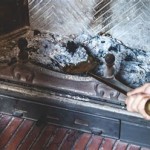How To Refinish A Brick Fireplace
Refinishing a brick fireplace is a project that can dramatically improve the aesthetic appeal of a living space. Over time, brick can become stained, discolored, or simply outdated, making a refinishing project a cost-effective alternative to a complete fireplace replacement. The process involves cleaning, repairing, and applying a desired finish, transforming the look of the fireplace without compromising its inherent structural integrity. This article provides a comprehensive guide to each step involved in refinishing a brick fireplace.
Preparing the Fireplace for Refinishing
The first and arguably most important step in refinishing a brick fireplace is thorough preparation. Proper preparation ensures that any applied finishes adhere correctly and that the final result is both durable and visually appealing. This stage involves cleaning the brick surface, addressing any existing damage, and protecting the surrounding area from dust and debris.
Begin by covering the surrounding floor and furniture with drop cloths or plastic sheeting. This will protect these surfaces from splashes and dust generated during the refinishing process. Secure the protective coverings with painter's tape to prevent them from shifting during the work.
Next, clean the brick surface. This often involves removing soot, dust, and other accumulated grime. A wire brush can be used to scrub the brick, particularly in areas with heavy soot buildup. For more stubborn stains, a solution of trisodium phosphate (TSP) and water can be used. Always follow the manufacturer's instructions when using TSP, and wear appropriate protective gear, including gloves and eye protection. Apply the TSP solution to the brick, let it sit for a few minutes, and then scrub vigorously with the wire brush. Rinse the brick thoroughly with clean water to remove any remaining TSP residue.
Once the brick is clean, inspect it for any damage, such as cracks or loose mortar. These issues should be addressed before applying any finish. Small cracks can be filled with a brick crack filler that matches the color of the existing brick. Loose or crumbling mortar should be removed with a chisel and hammer, and then the joints should be re-mortared using a mortar mix specifically designed for brickwork. Allow the mortar to cure completely according to the manufacturer’s instructions before proceeding with the refinishing process.
Applying a Finish to the Brick
After the fireplace is clean and repaired, the next step is to apply the desired finish. There are several options available, each offering a different look and level of durability. The choice of finish will depend on personal preference and the overall aesthetic of the room.
One popular option is to paint the brick. Painting provides a completely uniform color and can be used to dramatically alter the appearance of the fireplace. Before painting, apply a primer specifically designed for masonry. This will help the paint adhere to the brick and prevent moisture from seeping into the brick. Choose a paint that is suitable for high temperatures, particularly if the fireplace is frequently used. Apply the paint in thin, even coats, allowing each coat to dry completely before applying the next. Two or three coats may be necessary to achieve full coverage.
Another option is to whitewash or limewash the brick. Whitewashing involves applying a diluted mixture of paint and water to the brick, creating a translucent effect that allows some of the brick's natural color and texture to show through. Limewashing is a similar process, but it uses a mixture of lime and water instead of paint. Both whitewashing and limewashing provide a rustic, aged look. The application process is similar to painting, but the mixture is typically applied in thinner coats to achieve the desired level of transparency.
For individuals seeking to preserve the natural look of the brick while adding a layer of protection, a clear sealant can be applied. Sealants protect the brick from moisture and staining without altering its color. Choose a sealant specifically designed for masonry and follow the manufacturer's instructions carefully. Apply the sealant in thin, even coats, allowing each coat to dry completely before applying the next.
Addressing Specific Refinishing Goals
Beyond the standard cleaning, repair, and finishing stages, specific refinishing goals may require additional steps and considerations. For example, if the goal is to lighten the brick, the process might involve bleaching the brick prior to applying a finish. Conversely, if the goal is to darken the brick, staining or using a darker-colored paint may be required.
To lighten brick, a solution of bleach and water can be used. Apply the solution to the brick, let it sit for a specified amount of time, and then scrub thoroughly with a brush. Be sure to wear appropriate protective gear, including gloves and eye protection, when working with bleach. Rinse the brick thoroughly with clean water after bleaching. It is crucial to test the bleach solution on a small, inconspicuous area of the brick first to ensure that it does not damage the brick or cause unwanted discoloration.
To darken brick, a brick stain can be applied. Brick stains are specifically designed to penetrate the brick and provide a long-lasting color change. Choose a stain that is compatible with the type of brick and follow the manufacturer's instructions carefully. Apply the stain in thin, even coats, using a brush or sprayer. Allow the stain to dry completely before applying any additional coats. The number of coats required will depend on the desired depth of color. As with other finishes, it is recommended to test the stain on a small, inconspicuous area first.
If the goal is to create a more textured look, consider applying a textured paint or finish. Textured paints contain small particles that create a raised surface, adding depth and dimension to the brick. These paints are typically applied with a brush or roller, and the texture can be further enhanced by using a variety of application techniques. Another option is to apply a skim coat of mortar to the brick before painting or staining. This will create a rough, uneven surface that adds character to the fireplace.
Regardless of the chosen finish or specific refinishing goal, proper preparation, careful application, and attention to detail are essential for achieving a successful and long-lasting result. Allowing adequate drying time between coats and following the manufacturer's instructions for all products used will contribute to a professional-looking refinished brick fireplace.

16 Red Brick Fireplace Makeover Ideas
How To Paint A Red Brick Fireplace Look Like Stone

16 Red Brick Fireplace Makeover Ideas

25 Beautiful Diy Brick Fireplace Makeovers

10 Fireplace Makeover Ideas Before And After Regency

Brick Fireplace Makeover Before And After Decorating Painting Id Painted Fireplaces Paint

How To Whitewash A Brick Fireplace Easiest Method For 2024
:max_bytes(150000):strip_icc()/MadetobeaMommaBefore-5bb2476446e0fb002607ad4f.jpg?strip=all)
Before And After Fireplace Makeovers

10 Fireplace Makeover Ideas Before And After Regency

How To Plaster A Brick Fireplace So Much Better With Age
Related Posts








